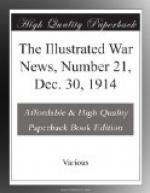The Admiralty announced on September 13 that the Australian Squadron had occupied, on the 11th, “the town of Herbertshoehe, in the island of Neu Pommern (late New Britain), which is an island in the Bismarck Archipelago; this island lies due east from German New Guinea.” At Rabaul, New Britain, on the 13th, a British Proclamation was read, with a special one in “pidgin” English for the natives. The German Acting-Governor, Dr. Haber, surrendered on the 21st. Our photographs show: (1) German troops marching into Herbertshoehe to surrender; (2) A German building at Friedrich Wilhelmshafen, now garrison headquarters; (3) The Australian Naval Brigade marching through Rabaul; and (4) Dr. Haber, followed by the German Commander, riding into Herbertshoehe to surrender.
_______________________________________________________
___________________ THE ILLUSTRATED WAR NEWS, DEC. 30, 1914—[Part 21]—27
[Illustration: THE NEUTRALITY OF THE SCANDINAVIAN POWERS: THE KINGS OF NORWAY, SWEDEN, AND DENMARK, WHO MET IN CONFERENCE AT MALMO.]
The three Northern Monarchs whose portraits are given above are: (1) King Haakon of Norway; (2) King Gustav of Sweden; (3) King Christian of Denmark. King Gustav was the convener of the meeting, the object of which was to arrive at an understanding by means of which the Scandinavian countries might be able to draw closer together in view of the interests common to them all as neutrals. The motive was to maintain the neutrality and independence of the three peoples, and at the same time to mitigate as far as possible the serious inconveniences which all the three Northern States have suffered in regard to the supplies of the necessaries of life and in their general economic condition in consequence of the existence of a state of war in Europe.—[Photos. by Russell, Florman, and Bieber.]
_______________________________________________________
___________________ 28—THE ILLUSTRATED WAR NEWS, DEC. 30, 1914.—[Part 21]
[Illustration: THE ENEMY AS PORTRAYED BY HIMSELF ON CHALK: THE GERMAN SOLDIER-CAVEMAN AS ARTIST IN THE AISNE QUARRIES.]
In more ways than one, the German soldier would seem on occasion to represent, as it were, a reverting to primitive type: to the barbaric European of centuries back in the world’s history. The “reversion” takes many shapes, and we have seen instances of it during the war in various ways. It is surely readily recognisable, for example, in that spirit of sheer ruthlessness which inspired the perpetration of the inhuman outrages that have laid Belgium waste, and of the killing of harmless women and children by naval shells at the peaceful watering-place of Scarborough. Another and more innocuous form of going back to the habits and methods typical of primitive man, is, perhaps, traceable in the illustrations given above. They are some of the handiwork of the twentieth-century German military cavemen of




